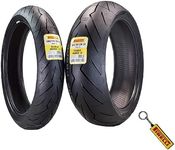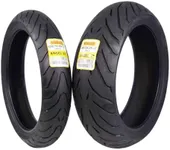Buying Guide for the Best Street Motorcycle Tires
Choosing the right street motorcycle tires is crucial for ensuring safety, performance, and comfort while riding. The right tires can significantly affect your bike's handling, grip, and overall ride quality. When selecting motorcycle tires, it's important to consider various specifications that will match your riding style, the type of motorcycle you have, and the conditions in which you'll be riding. Here are some key specs to consider and how to navigate them to find the best fit for you.Tire SizeTire size is a critical specification that includes the width, aspect ratio, and diameter of the tire. It is important because it affects the bike's handling, stability, and speedometer accuracy. Tire sizes are usually indicated in a format like 120/70ZR17, where 120 is the width in millimeters, 70 is the aspect ratio (height as a percentage of width), and 17 is the diameter in inches. To pick the right size, refer to your motorcycle's manual or the existing tire's sidewall. Using the correct size ensures optimal performance and safety.
Tread PatternThe tread pattern of a tire affects its grip on different surfaces and in various weather conditions. Tread patterns can range from slick (no tread) for maximum contact on dry roads to deep grooves for better water dispersion in wet conditions. For street riding, a balanced tread pattern that offers good grip in both dry and wet conditions is ideal. If you ride in rainy areas, look for tires with more grooves and sipes to channel water away. For dry climates, a less aggressive tread pattern may suffice.
Tire CompoundThe tire compound refers to the rubber mixture used in the tire, which affects its grip, durability, and performance. Softer compounds provide better grip but wear out faster, making them suitable for performance-oriented riders. Harder compounds last longer but may offer less grip, ideal for long-distance touring. Some tires use dual compounds, with a harder center for durability and softer edges for better cornering grip. Choose a compound based on your riding style: aggressive riders may prefer softer compounds, while commuters might opt for harder ones.
Load RatingThe load rating indicates the maximum weight a tire can safely carry. This is important for ensuring that your tires can handle the combined weight of your motorcycle, rider, passenger, and any luggage. The load rating is usually a number found on the tire's sidewall, corresponding to a specific weight in pounds or kilograms. To pick the right load rating, check your motorcycle's manual for the recommended rating and ensure your tires meet or exceed this value to maintain safety and performance.
Speed RatingThe speed rating of a tire indicates the maximum speed at which the tire can safely operate. This is important for ensuring that your tires can handle the speeds you intend to ride at. Speed ratings are denoted by letters (e.g., H, V, W) on the tire's sidewall, each corresponding to a specific speed range. To choose the right speed rating, consider your riding habits and the top speeds you typically reach. Ensure the speed rating matches or exceeds the maximum speed of your motorcycle to maintain safety and performance.
Tire TypeThere are different types of street motorcycle tires, including sport, touring, sport-touring, and cruiser tires. Each type is designed for specific riding styles and conditions. Sport tires offer maximum grip and performance for aggressive riding, while touring tires provide durability and comfort for long-distance travel. Sport-touring tires offer a balance between performance and longevity, and cruiser tires are designed for comfort and stability on long rides. Choose the tire type that best matches your riding style and the primary use of your motorcycle.



















